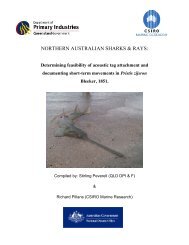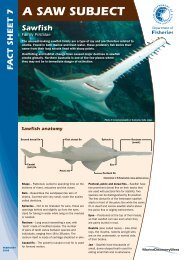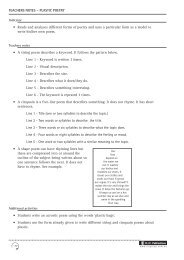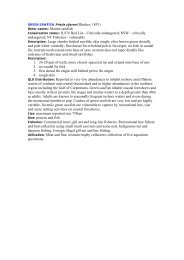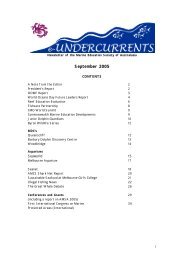The cultural significance of sharks and rays in Aboriginal societies ...
The cultural significance of sharks and rays in Aboriginal societies ...
The cultural significance of sharks and rays in Aboriginal societies ...
You also want an ePaper? Increase the reach of your titles
YUMPU automatically turns print PDFs into web optimized ePapers that Google loves.
<strong>The</strong> Wurrakwakwa <strong>rays</strong><br />
Sometimes groups <strong>of</strong> ancestors b<strong>and</strong>ed together dur<strong>in</strong>g their<br />
ancestral travels. For several clans <strong>of</strong> the An<strong>in</strong>dilyakwa people<br />
<strong>of</strong> Groote Eyl<strong>and</strong>t, collectively known as the Wurrakwakwa<br />
(pronounced: wurr-ahg-WAHG-wuh), a school composed <strong>of</strong><br />
many different ray species was responsible for creat<strong>in</strong>g a series<br />
<strong>of</strong> l<strong>and</strong> estates dur<strong>in</strong>g their journey across the isl<strong>and</strong>. Accord<strong>in</strong>g<br />
to the story, sawfish ancestors, accompanied by estuary<br />
whip<strong>rays</strong> (Dasyatis fl uviorum), shovelnose <strong>rays</strong>, eagle <strong>rays</strong>,<br />
<strong>and</strong> others left the ma<strong>in</strong>l<strong>and</strong> search<strong>in</strong>g for a home. <strong>The</strong>y first<br />
stopped on Bickerton Isl<strong>and</strong>, but found it too uncomfortable.<br />
<strong>The</strong>y cont<strong>in</strong>ued onwards, eventually runn<strong>in</strong>g <strong>in</strong>to Groote<br />
Eyl<strong>and</strong>t. <strong>The</strong>y knew that their home was at the eastern end <strong>of</strong><br />
the isl<strong>and</strong>, but they could not cont<strong>in</strong>ue overl<strong>and</strong> because they<br />
were now transformed <strong>in</strong>to fishes. Sawfish then leapt ahead,<br />
goug<strong>in</strong>g a riverbed across the isl<strong>and</strong> us<strong>in</strong>g his toothy snout. As<br />
the tide rushed <strong>in</strong> beh<strong>in</strong>d him, the <strong>rays</strong> followed <strong>in</strong> a jostl<strong>in</strong>g<br />
pack, eventually reach<strong>in</strong>g a shallow bay on the eastern shore.<br />
<strong>The</strong>y realised that this was their eternal rest<strong>in</strong>g place, so they<br />
circled around the bay <strong>in</strong> joy. As the <strong>rays</strong> circled around <strong>and</strong><br />
around, some <strong>of</strong> them were speared by ancestral hunters,<br />
establish<strong>in</strong>g that <strong>rays</strong> were to be a prized food source for<br />
mank<strong>in</strong>d forever.<br />
In the pa<strong>in</strong>t<strong>in</strong>g pictured (figure 6), we see the ancestral sawfish<br />
Yukwurrirr<strong>in</strong>dangwa (pronounced: yook-wurr-irr-<strong>in</strong>-DUNGwuh)<br />
as he carves-out the Angurugu River with his toothy saw.<br />
Follow<strong>in</strong>g beh<strong>in</strong>d are three estuary whip<strong>rays</strong>, Yimaduwaya<br />
(pronounced: yim-uh-du-WAH-yuh). An ancestral hunter is<br />
depicted on the riverbank watch<strong>in</strong>g the sacred <strong>rays</strong> pass. He is<br />
poised with a spear to harvest a few <strong>of</strong> these delicious fishes for<br />
a feast. For the clans l<strong>in</strong>ked through the story <strong>of</strong> these totemic<br />
<strong>rays</strong>, this sacred journey established many social, ceremonial,<br />
<strong>and</strong> economic ties between them. <strong>The</strong>se <strong>rays</strong> are so central to<br />
Wurrakwakwa clan identity <strong>and</strong> ideas <strong>of</strong> l<strong>and</strong> ownership that<br />
when a new aged-care facility was constructed along the banks<br />
<strong>of</strong> the Angurugu River recently, the An<strong>in</strong>dilyakwa naturally<br />
decided to make the build<strong>in</strong>g <strong>in</strong> the shape <strong>of</strong> the ancestral<br />
sawfish!<br />
F<strong>in</strong>al thoughts<br />
As is clear from the follow<strong>in</strong>g brief examples drawn from<br />
the dozens <strong>of</strong> shark <strong>and</strong> ray ancestors found among Top End<br />
Aborig<strong>in</strong>al <strong>societies</strong>, <strong>in</strong>digenous peoples have much to teach<br />
Western society about valu<strong>in</strong>g <strong>sharks</strong> <strong>and</strong> <strong>rays</strong>. Societies such<br />
as the Yolngu <strong>and</strong> the An<strong>in</strong>dilyakwa view elasmobranchs <strong>in</strong><br />
a much more balanced way, f<strong>in</strong>d<strong>in</strong>g them worthy <strong>of</strong> respect<br />
<strong>and</strong> admiration. Instead <strong>of</strong> fear<strong>in</strong>g the predatory prowess<br />
<strong>of</strong> these fasc<strong>in</strong>at<strong>in</strong>g fishes, Aborig<strong>in</strong>al people see <strong>in</strong> them<br />
strength <strong>and</strong> values which are a model for human behavior.<br />
Very few <strong>sharks</strong> <strong>and</strong> <strong>rays</strong> ever pose a threat to mank<strong>in</strong>d, <strong>and</strong><br />
now our activities (e.g., recreational <strong>and</strong> commercial fish<strong>in</strong>g;<br />
disturbance/loss <strong>of</strong> habitat) threaten the survival <strong>of</strong> species<br />
such as the freshwater sawfish <strong>and</strong> the grey nurse shark. If we<br />
can change our attitudes about these misunderstood animals<br />
<strong>and</strong> utilise historical biological <strong>in</strong>formation on specific species<br />
through <strong>in</strong>digenous connections, we will have a better chance<br />
<strong>of</strong> susta<strong>in</strong>ably manag<strong>in</strong>g these species.<br />
Acknowledgements<br />
Figure 6. <strong>The</strong> ancestral sawfish carves-out the Angurugu River on<br />
Groote Eyl<strong>and</strong>t followed by three creator st<strong>in</strong>g<strong>rays</strong>. An ancestral<br />
hunter watches from the riverbank, wait<strong>in</strong>g to spear some <strong>rays</strong> for<br />
a feast. Culture: An<strong>in</strong>dilyakwa, Clan: Mam<strong>in</strong>yamanja, Artist:<br />
Nek<strong>in</strong>gaba Mam<strong>in</strong>yamanja, Date: c. 1980. Collection <strong>of</strong> the author.<br />
<strong>The</strong> follow<strong>in</strong>g organisations/<strong>in</strong>dividuals are acknowledged for their<br />
contributions: Fund<strong>in</strong>g: Natural Heritage Trust <strong>and</strong> the Fisheries<br />
Resources Research Fund (Australian Government Department<br />
<strong>of</strong> Agriculture, Fisheries <strong>and</strong> Forestry). Coord<strong>in</strong>ation <strong>of</strong> project:<br />
Mar<strong>in</strong>e Industries Environment Branch <strong>and</strong> the Bureau <strong>of</strong> Rural<br />
Sciences (Australian Government Department <strong>of</strong> Agriculture,<br />
Fisheries <strong>and</strong> Forestry). Artwork: Brett Cullen <strong>and</strong> Trish Hart.<br />
Reviewers: David Kaus, Stirl<strong>in</strong>g Peverell, John Stevens, Carolyn<br />
Stewardson, Albert Caton <strong>and</strong> John Ackerman.<br />
© Matthew McDavitt (MTMcDavitt@aol.com).<br />
This <strong>in</strong>formation sheet may be copied for educational purposes.<br />
For any other purpose please contact the author.<br />
5





